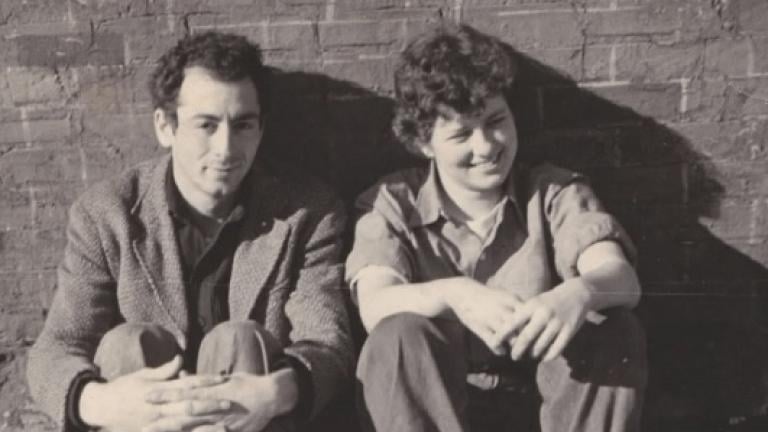We meet a Chicago artist who has been painting since the 1940s and is just now getting his due on Chicago Tonight at 7:00 pm. Michigan native, Morris Barazani, has been filling canvases for over 60 years. His abstract paintings utilize interplay between stiletto shapes and vibrant colors. Barazani studied at Stanford University following his tour in WWII. Afterwards, he studied at the Institute of Design from 1947-1948, aligning himself with the Chicago Bauhaus principles taught by Laszlo Moholy Nagy, who founded the New Bauhaus: Chicago School of Design in 1937. View a photo gallery of Barazani's paintings and learn more about the Institute of Design below.
Bauhaus was the first school of modern design in the world in 1920, originating in Germany by Walter Gropius. The school was created at a time of development in the industrial age when things once created by craftsmen like furniture, could now be mass produced by machinery. Out of this, a new breed of designer specialists was born. The Bauhaus school was created to train people to bring in a human dimension to technology.
Moholy headed the visual fundamentals program at the Bauhaus. Bauhaus philosophy was to use technology to improve the quality of human life. In 1933, the school was closed by the Nazis, but by then it had established itself as an internationally reputable institute and many teachers were asked to teach abroad. In 1937, Moholy came to Chicago at the invitation of the Association of Arts and Industries to found a design school, dubbed the new Bauhaus. The school was closed for a year after association members withdrew their support because they felt Moholy’s school of thought was too experimental.
Moholy found a member of the association and chairman of the Container Corporation of America to help him reopen the school in 1938 under a new name, the Chicago School of Design, which adopted its present title, Institute of Design (ID), in 1944. Moholy was a distinguished painter, photographer, graphic designer, and above all, an educator. Moholy died in 1946 at age 51, but left behind a well-established legacy at the Institute of Design that continued to expand.
Hugh Musick, the Associate Dean and Director of Executive Education at ID, comments on the evolution of the institute.
 “The Institute of Design is nothing like an art school anymore, it’s more like a business think-tank,” he said.
“The Institute of Design is nothing like an art school anymore, it’s more like a business think-tank,” he said.
In 1948, ID became part of the Illinois Institute of Technology.
“The school was hovering at the point of being irrelevant, and in the mid-50s was almost out of business,” Musick said.
The school brought in the chief designer from the largest industrial design company, Jay Doblin, to become the director.
“He [Doblin] said that the way design was currently practiced, all decisions about what to make happened before the product got to the designer and all the designer had to do was make it look  pretty. He said design had the capability to help a company figure out what to make in the first place. Designs need to evolve as a profession like medicine and law,” said Musick.
pretty. He said design had the capability to help a company figure out what to make in the first place. Designs need to evolve as a profession like medicine and law,” said Musick.
From the mid-50s on, the school was dedicated to a methodological approach to design.
“What that means today is that we work with global organizations to help figure out what to do next. It begins with understanding of ordinary people and what goes on in their lives,” said Musick.
The Chicago Institute of Design focuses on a human-centered design, acknowledging the shift in society from the age of mass to the age of specialization.
The school celebrates its 75th anniversary this year.
Learn more about current work being done at the Institute of Design in the PDFs below.















